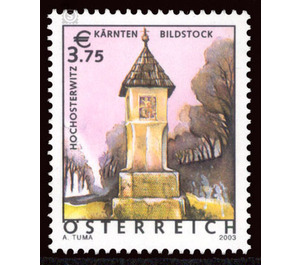Holiday Country Austria - Austria / II. Republic of Austria 2003 - 375 Euro Cent
Theme: Economy & Industry
| Country | Austria / II. Republic of Austria |
| Issue Date | 2003 |
| Face Value | 375.00 |
| Printing Type | Photogravure |
| Stamp Type | Definitive |
| Item Type | Stamp |
| Chronological Issue Number | 1762 |
| Chronological Chapter | OOS-OE2 |
| SID | 527751 |
| In 59 Wishlists | |
North of the highly visible castle Hochosterwitz, the most magnificent landmark of Carinthia, runs the Seeberg highway, which leads from St.Veit an der Glan coming to Brückl and from there south towards the Slovenian border, the Seeberg strives. Just north of the castle branches of this highway 82, the access roads to the south St. Martin and the northern Unterbrückendorf from. Exactly at this point (in the area of the municipality of St. Georgen am Längsee) is the 16th century gothic canvass, which Adolf Tuma depicted on the new brand. The actual four-edged shrine, which stands on two massive octagonal pedestals, the following representations are to be seen: St. Martin in the east, St. Christopher in the south, (probably much later, rather puzzling) symbols in the west and a Pieta in the north.With shrugs Crossroads, on hills, on pilgrimage paths or in centers or ends of the village are often referred to special events, miracles or even saints with a reference to place names, as here St. Martin. In contrast to the Marterln they rarely remind of misfortunes. Especially here in Carinthia, there are masonry, particularly richly painted, especially decorative shrines in large numbers, which are almost always protected by a steep and very often round, sweeping tent roof.


